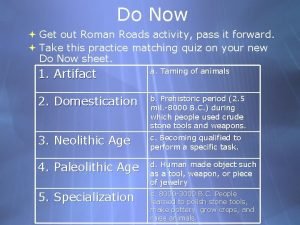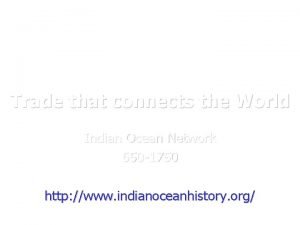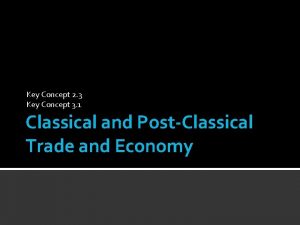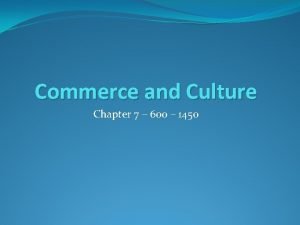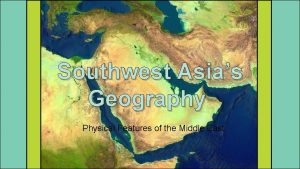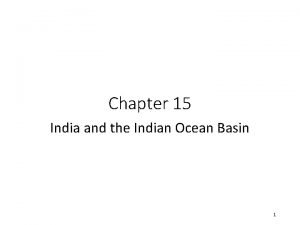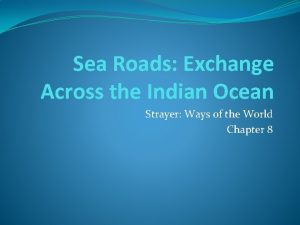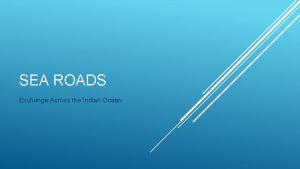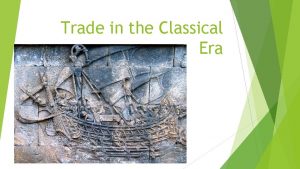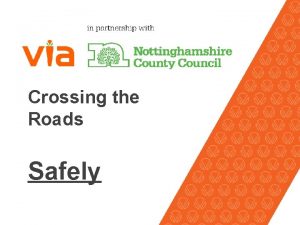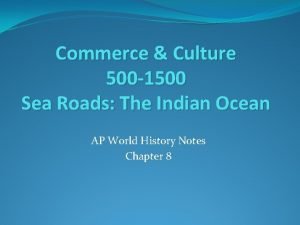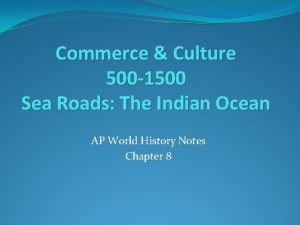Sea Roads The Indian Ocean Trade Or why









- Slides: 9

Sea Roads: The Indian Ocean Trade Or: why do we continue to question the hallucinogenic properties of nutmeg, and will Mc. Dowell overdose on it?

Today’s Learning Objectives: U 2, E: Explain the causes of the growth of networks of exchange after 1200 U 2, F: Explain the effects of the growth of networks of exchange after 1200 U 2, G: Explain the role of environmental factors in the development of networks of exchange in the period from 1200 to 1450 And the other 2 about culture and similarities. It’s late and I’m tired.

Indian Ocean Trade Goods East Africa: ivory, gold, iron, slaves, tortoiseshell, quartz, animal hide Middle East: frankincense, myrrh, perfume India: grain, cotton, spices, pepper, timber, precious stones Southeast Asia: tin, sandalwood, cloves, nutmeg, mace China: silk, porcelain, tea

Indian Ocean Trade: Southeast Asia Trade along the Indian Ocean produced massive cultural changes throughout the world, perhaps most dramatically in Southeast Asia New trade empires (Srivijaya, Majapahit, etc) sprang up in the region, based on the spice trade and taxation of passing ships Through trade, Buddhism and Hinduism made their way to Southeast Asia, resulting in both cultural change (rulers used the new religions to legitimize their rule) and new architecture (Angkor Wat, Borobudur)

Indian Ocean Trade: Monsoons and Muslims Indian Ocean trade, especially between East Africa and India, was facilitated by the monsoon winds regular wind patterns making travel on the Indian Ocean predictable and profitable Through the period 600 -1450, Muslim merchants came to control the trade routes of the Indian Ocean, establishing merchant colonies in trade ports which would spread their religion to East Africa and Indonesia By 1400, Indonesia was home to the Malacca Sultanate—the 1 st Muslim rulers of what would become the world’s most populous Muslim nation

Indian Ocean Trade: East Africa Indian Ocean trade radically altered the livelihoods of East African people After the rise of Islam and the takeoff of Indian Ocean trade, East Africa housed a large number of independent trade-based city-states East Africa was the first major site of race-based slave trade, with most slaves from the region sold in the Middle East The people there became known as the Swahili, the name of their language—a language which was Bantu in its wording and grammar, but written with Arabic script

Indian Ocean Trade: East Africa The Swahili rapidly converted to Islam, and their rulers would claim Persian or Arab descent to further their prestige The gold the Swahili traded did not come from East Africa, but from many miles inland, where a kingdom known as Great Zimbabwe flourished from the 1000 s to the 1400 s Not much of Great Zimbabwe’s history is known, however, because of a lack of writing and its abandonment Hard to tell from this distance, but that wall is 32 feet high

Points of Interest, before we transition: The Shanga Lion, c. 1100, East Africa—ask what it’s made of!

And now, we make some maps! It was this or more Ibn Battuta…
 Modern roads vs roman roads venn diagram
Modern roads vs roman roads venn diagram Whether
Whether Indian ocean trade route
Indian ocean trade route What lay behind the flourishing of indian ocean commerce?
What lay behind the flourishing of indian ocean commerce? Sea roads as a catalyst for change southeast asia
Sea roads as a catalyst for change southeast asia Andreas carlsson bye bye bye
Andreas carlsson bye bye bye Why are expressways safer than other types of roads
Why are expressways safer than other types of roads Inlet of indian ocean between africa and asia
Inlet of indian ocean between africa and asia Indian ocean basins
Indian ocean basins Inlet of indian ocean between africa and asia
Inlet of indian ocean between africa and asia
